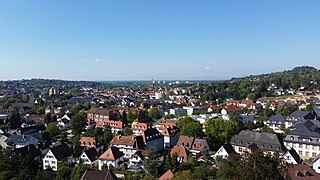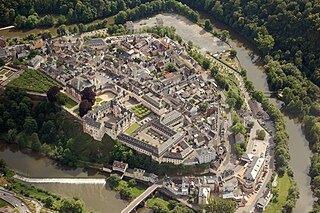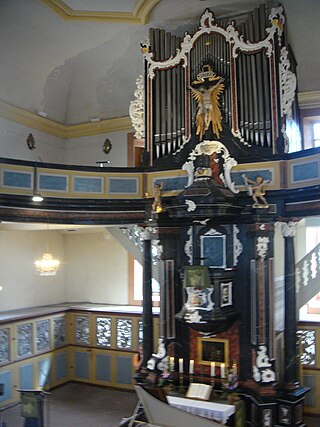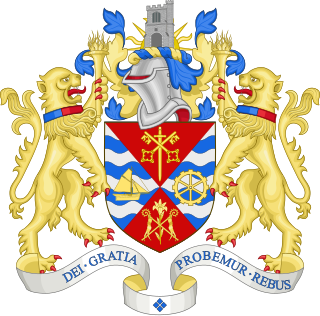
Wiesbaden is a city in central western Germany and the capital of the state of Hesse. As of June 2020, it had 290,955 inhabitants, plus approximately 21,000 United States citizens. The Wiesbaden urban area is home to approximately 560,000 people. Wiesbaden is the second-largest city in Hesse after Frankfurt am Main.

Bierstadt is a borough of the city of Wiesbaden, capital of the state of Hesse, Germany. It is located in the eastern part of the city, directly east of downtown Wiesbaden, and has about 12,300 inhabitants. Formerly an independent municipality, the settlement was incorporated into Wiesbaden on April 1, 1928. While Bierstadt can be translated "Beer Town," the name is actually derived from Brigid of Kildare, patron saint of Bierstadt (Birgidstadt).

Lahr ; Low Alemannic: Lohr) is a town in western Baden-Württemberg, Germany, approximately 50 km north of Freiburg im Breisgau, 40 km southeast of Strasbourg, and 95 km southwest of Karlsruhe. It is the second largest city in Ortenau (district) after Offenburg, and serves as an intermediate economic centre for the cities and towns of Ettenheim, Friesenheim, Kappel-Grafenhausen, Kippenheim, Mahlberg, Meißenheim, Ringsheim, Rust, Schuttertal, Schwanau and Seelbach.

Weilburg is, with just under 13,000 inhabitants, the third biggest town in Limburg-Weilburg district in Hesse, Germany, after Limburg an der Lahn and Bad Camberg.

Niedernhausen im Taunus is a municipality in the Rheingau-Taunus-Kreis in the Regierungsbezirk of Darmstadt in Hesse, Germany, with almost 15,000 inhabitants.

Taunusstein is the biggest town in the Rheingau-Taunus-Kreis in the Regierungsbezirk of Darmstadt in Hessen, Germany. It has 30,068 inhabitants (2020).

Bechtolsheim is an Ortsgemeinde – a municipality belonging to a Verbandsgemeinde, a kind of collective municipality – in the Alzey-Worms district in Rhineland-Palatinate, Germany. It belongs to the Verbandsgemeinde of Alzey-Land, whose seat is in Alzey.

Bad Camberg is, with 14,200 inhabitants, the second largest town in Limburg-Weilburg district in Hesse, Germany, as well as the southernmost town in the Regierungsbezirk of Gießen. It is located in the eastern Taunus in the Goldener Grund some 30 km north of Wiesbaden, 18 km southeast of Limburg an der Lahn, and 44 km northwest of Frankfurt, as well as on the German Timber-Frame Road. Bad Camberg is the central community of the Goldener Grund with good infrastructure, and a lower centre partly with a middle centre's function.

Frauenstein is the westernmost borough of the city of Wiesbaden, located in the Rhine Main Area near Frankfurt and capital of the federal state of Hesse, Germany. The borough has a population of approximately 2,400. The formerly independent village was incorporated into Wiesbaden in 1928.

Jünkerath is an Ortsgemeinde – a municipality belonging to a Verbandsgemeinde, a kind of collective municipality – in the Vulkaneifel district in Rhineland-Palatinate, Germany. It was th seat of the former Verbandsgemeinde of Obere Kyll.

Schierstein is a southwestern borough of Wiesbaden, capital of state of Hesse, Germany. First mentioned in historical records in 860, Schierstein was incorporated into Wiesbaden in 1926. Today the borough has about 10,000 residents. Situated on the Rhine River, Schierstein is known as the "Gateway to the Rheingau."

Dotzheim is a western borough of Wiesbaden, capital of the state of Hesse, Germany. It is the second largest borough of the city by area and, with over 27,000 inhabitants the second-most populated of Wiesbaden's suburban boroughs. It was the largest village in the former Duchy of Nassau. The formerly independent village was incorporated into Wiesbaden in 1928.

Kloppenheim is a borough of Wiesbaden, capital of the federal state of Hesse, Germany. Kloppenheim was incorporated into Wiesbaden in 1928. The adjacent boroughs are Naurod, Auringen, Medenbach, Igstadt, Bierstadt, and Heßloch.
Klarenthal Abbey is a former convent of the Order of Poor Ladies in the borough of Klarenthal in Wiesbaden, Germany. Klarenthal is the only abbey in present-day Wiesbaden.

Count John V of Nassau-Siegen, German: Johann V. Graf von Nassau-Siegen, official titles: Graf zu Nassau, Vianden und Diez, Herr zu Breda, was since 1475 Count of Nassau-Siegen and of half Diez. He descended from the Ottonian Line of the House of Nassau.
Lord Ulrich III of Hanau was Lord of Hanau from 1346 until his death. He was also governor in the Wetterau.

The Christophoruskirche is a Protestant church in the borough of Schierstein, Wiesbaden, Germany. It was built in 1752 to 1754 in the style of the late Baroque and Rococo.
Brand is a borough of Aachen, Germany, with about 18,000 residents. The borough lies in the south-east part of Aachen and borders Kornelimünster/Walheim, Forst, Oberforstbach und Eilendorf, as well as the town of Stolberg.

The coat of arms of the London Borough of Barking and Dagenham is the official coat of arms of the London Borough of Barking and Dagenham, granted on 1 September 1965.

Countess Mary of Nassau-Siegen, German: Maria Gräfin von Nassau-Siegen, official titles: Gräfin zu Nassau, Vianden und Diez, Frau zu Breda, was a countess from the House of Nassau-Siegen, a cadet branch of the Ottonian Line of the House of Nassau, and through marriage Countess of Nassau-Wiesbaden-Idstein.



















